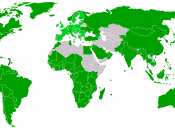Countertrade
Countertrade is an umbrella term covering a wide range of commercial mechanisms for reciprocal trade. Barter is probably the oldest and best known example, however others, such as offset, buyback, tolling and switch-trading, have also evolved to meet the requirements of a more sophisticated world economy. All of these generally involve the exchange of goods or services to finance purchases, rather than using cash alone. Countertrade, in its various forms, represents 10-15% of world trade. The importance of countertrade as a trading tool has increased since early 1970s -especially in markets where there is a shortage of foreign exchange and countertrade may be the only effective marketing mechanism for doing business.
Barter, is the oldest form of countertrade and involves the direct exchange of goods without any use of currencies. Offset, requires a seller to purchase from the buyer goods of an agreed value, usually a percentage of the original sales value of the export.
A countertrade broker is often used to facilitate the selling and marketing process of the original goods and his fee is added to the price. Offset is the method frequently used by governments in the sale of military and high-tech goods. Compensation or buyback, which requires a seller to purchase a specified amount of goods as a part payment. Terms are agreed for the buyback period and the value of the payment, which is added to the price of the goods. Infrastructure projects often use this type of finance, but with far more complex financial arrangements. A build-own-transfer (BOT) arrangement is an example of this, where a project company is established to finance, construct and own the project for a specified period. At the end of the period, provided that all debts relating to the project have been repaid, the seller transfers ownership...


